U.S. Businesses Support Femicide Protests in Mexico, but Trouble Looms Closer to Home
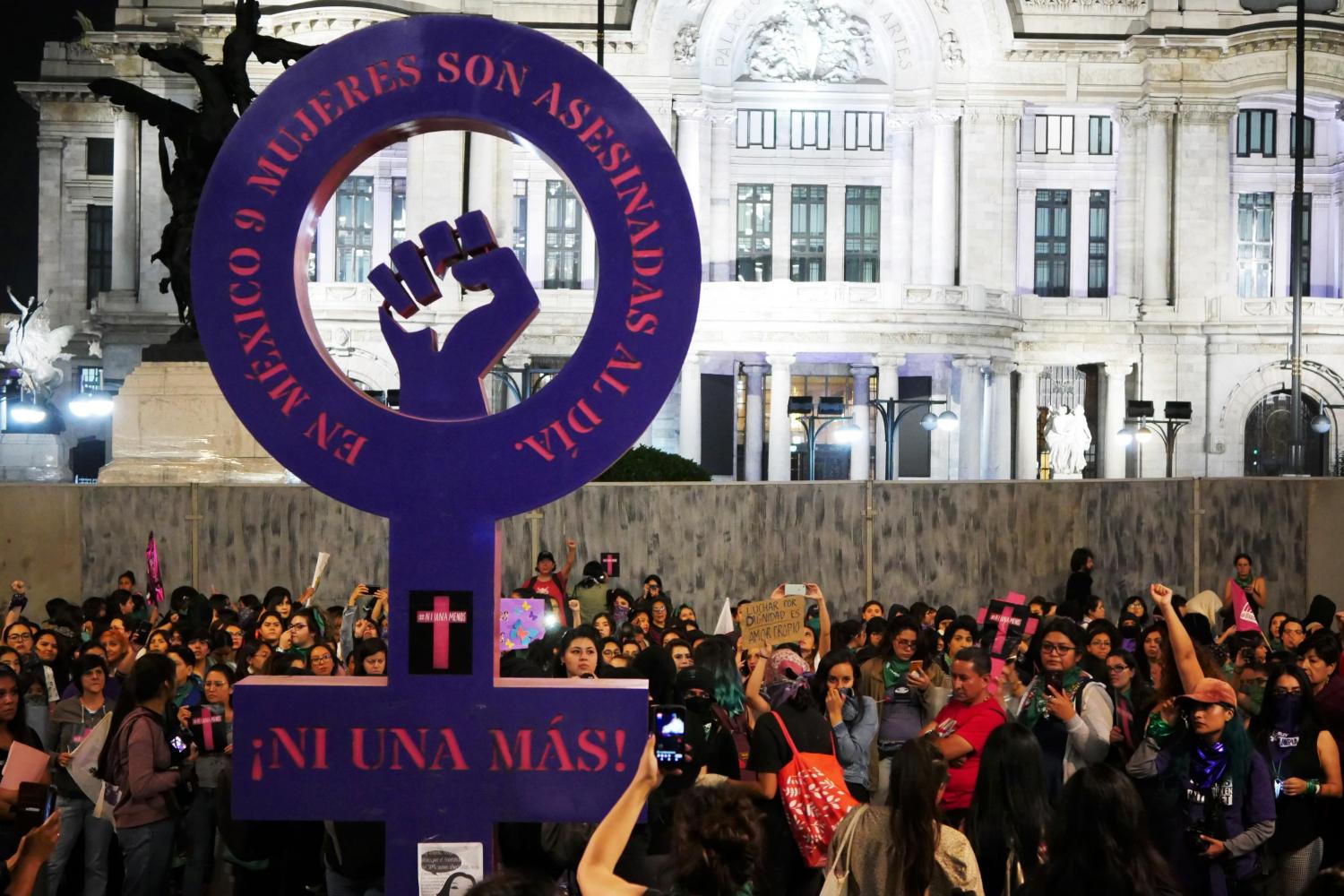
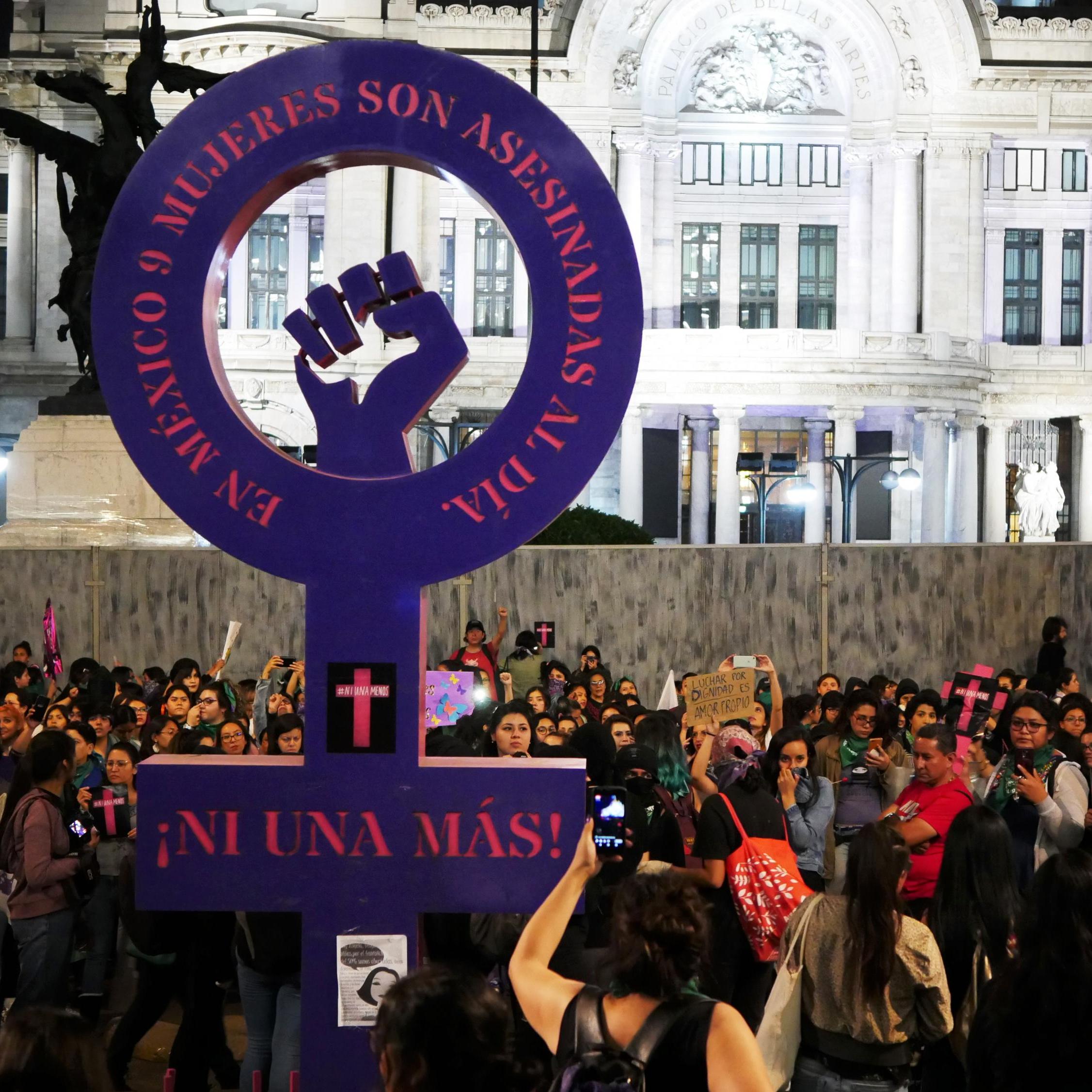
On Monday, hundreds of thousands of women in Mexico stayed home from work to call attention to a dramatic rise in the rate of female murders over the past several years. Several U.S.-based companies supported the massive nationwide protest by excusing their female employees for the day. That’s a good start, but with women’s rights under fire here in the U.S., business leaders may be called upon to take a stronger stand on gender equality at home as well as abroad.
In Mexico, women are besieged by violence
Women’s rights activists have long raised the alarm over a systematic failure to prosecute cases of violence against women in Mexico, especially violence involving family members. The violence has increased significantly in recent years, with some researchers tracking a 54 percent increase in women stabbed or strangled at home between 2012 and 2016.
The situation came to a head last August, when women in Mexico City took to the streets to draw attention to a high-profile rape. They also raised the alarm over the 1,812 women killed during the seven months leading up to August, a number that made Mexico the "second-deadliest place for women” in Latin America aside from Brazil.
When government fails to protect
The August street protest may have also reflected disappointment with the policies of Mexican President Andrés Manuel López Obrador. Similar protests ensued over the next several months, including one that occurred on the 2019 International Day for the Elimination of Violence against Women on November 25. (including a protest in Mexico City, shown in the photo above)
Obrador swept into office last year on the promise of support for women’s rights, but instead his administration has been stepping back. One example cited by critics is the termination of a successful social program that subsidized the costs of professional daycare. It was replaced with a voucher system that encourages female relatives to care for the children of working women.
Last year, the Obrador administration also announced plans to defund women’s shelters and instead provide cash payments to women facing domestic violence. The cash plan was dropped after a furious backlash from advocates, who argued that cash in hand would put women in even more danger from familial violence. However, the administration still cut funding for domestic violence shelters.
A silent demonstration that (almost) worked
The ongoing failure to prioritize violence against women set the stage for Monday’s “A Day Without Women” protest.
In terms of attracting media attention, the action was a success. Reports of empty offices, factories and other places of work flooded the international press.
“Countless thousands of women and girls across Mexico have joined a historic strike to protest against the country’s startling rates of gender-based violence – and the government’s failure to respond to the crisis in which more than ten women are murdered every day,” reported The Guardian, in a representative story.
Coverage of Monday’s protest also reflected well on the businesses that supported their female workers.
NPR was among the news organizations reporting that Sears and Walmart provided a paid day off for women to participate in the protest. The Washington Post additionally reported that Ford and several other major corporations supported the action as well, and Buzzfeed News noted that male employees at a Hilton Hotel wore purple ribbons in support.
In terms of provoking decisive action from the Obrador administration, however, Monday’s action appears to have fallen short.
Reporting from Mexico City, Buzzfeed’s Mexico Bureau Chief Karla Zabludovsky noted that activists are already anticipating a rise in violence against women as reaction to the protest sets in. She also reported that President Obrador appears more inclined to appeasement than definitive action.
“As women’s anger has risen, so have his administration’s missteps,” Zabludovsky wrote, describing the president’s reaction as a mere shrug:
“During a morning press conference last week, a woman reporter asked López Obrador to protect her against a male colleague who had told her he wished she was gunned down.
‘We’d have to hear your colleague's version,’ López Obrador responded. ‘Why not forgive each other?’”
Trouble looming at home
With violence against women in Mexico seemingly poised to escalate, U.S. companies may have to step up their support for women’s rights in order to preserve their reputations when it comes to securing their reputations when it comes to corporate social responsibility.
The problem has also begun hitting closer to home in recent months, as manifested by efforts to prevent women and girls from access to reproductive healthcare.
Last fall, Quartz noted that the Trump administration has decreased funding for sex education except for abstinence-only programs, while enabling organizations to implement faith-based denials of health services.
Quartz also reported that U.S. government websites have also begun replacing science-based language with terms that promote “a view of reproductive health informed by conservative Christian values rather than scientific research or gender inclusiveness.”
The administration’s preference for restricting access to reproductive health care is also reflected in foreign policy.
Last September, for example, U.S. Department of Health and Human Services Secretary Alex Azar informed the United Nations General Assembly that the U.S. is opposed to certain language intended to articulate rights for women and girls.
“We do not support references to ambiguous terms and expressions, such as sexual and reproductive health and rights in U.N. documents,” he wrote in a prepared statement, “Because they can undermine the critical role of the family and promote practices, like abortion, in circumstances that do not enjoy international consensus and which can be misinterpreted by U.N. agencies.”
In addition to speaking on behalf of the U.S., Azar’s statement was also co-signed by 18 countries that have a notoriously mixed record on women’s rights: Bahrain, Belarus, Brazil, Democratic Republic of the Congo, Egypt, Guatemala, Haiti, Hungary, Iraq, Libya, Mali, Nigeria, Poland, Russia, Saudi Arabia, Sudan, United Arab Emirates and Yemen.
If U.S. business leaders are truly concerned about gender diversity, in the U.S. and elsewhere, it may no longer be sufficient to advocate for women as a matter of internal company policy. As with the other foundational issues of today, including gun safety and the climate crisis, business leaders may be called upon to stand up for women’s rights on the broader stage of public policy.
Image credit: Thayne Tuason/Wiki Commons
Nordstrom Embarks on New Drive for Women’s Rights
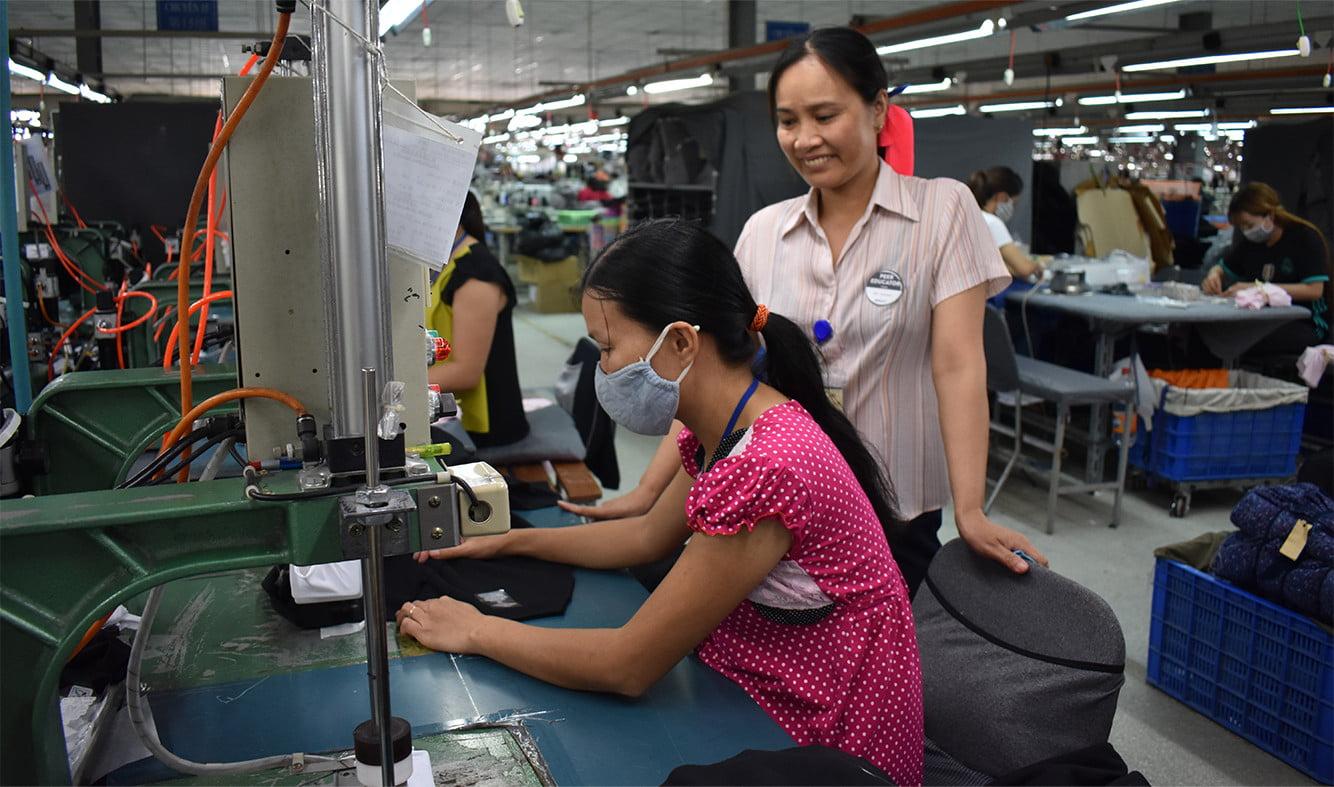

For all the progress made in women’s rights in recent decades, reproductive health continues to be a zone of intense conflict. Women’s reproductive rights in the U.S. were largely defined under the Supreme Court’s 1973 Roe v. Wade decision, but they have been eroded by a series of federal and state laws that restrict access to abortion. The situation has already forced business leaders to confront shortcomings in their own diversity efforts and advocate more broadly for women. The question now is how to carry the conversation to the next level, and Nordstrom has just provided one solution.
(Some) businesses speak up in support of reproductive health rights
One sign of corporate advocacy on reproductive rights occurred last June. One week after the international women’s rights conference Women Deliver occurred in Vancouver, Canada, 180 business leaders signed on to a brief but powerful full-page statement in the New York Times in support of reproductive care, including abortion.
Under the headline “Don’t Ban Equality,” the statement made a clear bottom line case for women’s health rights:
“Restricting access to comprehensive reproductive care, including abortion, threatens the health, independence and economic stability of our employees and customers…It impairs our ability to build diverse and inclusive workforce pipelines, recruit top talent across the states, and protect the well-being of all the people who keep our businesses thriving day in and out.”
An important step up on women’s rights
The Don’t Ban Equality effort appears to have gone dormant in terms of media attention, but meanwhile, Nordstrom embarked on its own path and took an important step last week, when it announced new human rights goals for its suppliers.
The new announcement builds on Nordstrom’s ongoing partnership with the global advocacy organization BSR.
Nordstrom has been working with BSR since 2007, and partnership has expanded significantly in recent months. After 12 years, as of early 2019, its programs reached approximately 12,000 factory workers with services relating to women’s health and finance, as well as anti-violence measures.
Last June, Nordstrom announced a new expansion of its women’s equality work with BSR to reach an estimated 75,000 workers in Vietnam, India and Bangladesh.
The announcement last week provides Nordstrom with the potential to wield a broader influence across its supply chain.
The new announcement continues expanding the relationship with BSR while also bringing in a new partner, the organization CARE.
By virtue of its new relationship with CARE, Nordstrom now has a platform to take an unequivocal stand on women’s reproductive rights.
As a matter of official policy, CARE states that “access to quality sexual and reproductive health is both a fundamental human right and a critical development issue,” further arguing that “all women, men, and young people should have equitable access to the information and services they need to realize their rights and attain the highest possible standard of sexual and reproductive health – free of discrimination, stigma, coercion, and violence.”
CARE also provides Nordstrom with a springboard for future advocacy efforts involving public policy. The organization maintains that providing direct health services is a critical effort, but it is not sufficient to guarantee health rights.
“…large-scale and sustainable change requires that we address underlying and systemic factors,” CARE states, "Including gender inequality, policy barriers, and power imbalances that have an impact on health.”
So far Nordstrom has not specified where its support for CARE will focus, except to note that a grant will go to “programs aimed to remove the root causes of poverty experienced by women.”
Nordstrom commits to women working across its supply chain
Whether Nordstrom chooses to exercise its new power in the field of legislative advocacy in the U.S. is another matter entirely.
Still, the new human rights effort appears to be priming the pump for raising grassroots awareness of the challenges and opportunities facing women around the globe, and here in the U.S.
The new human rights goals provide shoppers with transparency about the situation of women who make the clothes they buy.
Through the new guidelines, Nordstrom has committed to transitioning 90 percent of its “Nordstrom Made” products to factories that are engaged in women’s initiatives, with an additional commitment to ensure those products can be traced to their source.
The initiative also includes living wage goals and additional investments in training and resources in Nordstrom’s global supply chain.
The company may be on to something. Nordstrom has been keeping a sharp eye on consumer trends, as evidenced by its recent foray in the resale field as well as its ahead-of-the-pack decision to stop carrying the controversial Ivanka brand in 2017.
Also of interest is the company’s decision to host pop-up shops by the beauty company Glossier, which is among the high-profile supporters of the Don’t Ban Equality statement.
In a public statement on its new human rights goals, the company’s Jennifer Jackson Brown remarked that "Nordstrom is committed to offering our customers a selection of products they can feel good about because they know they're made in a responsible way.”
That statement may resonate in powerful - and perhaps unexpected ways - as the battle over women’s reproductive health plays out here in the U.S. and around the world.
Image credit: BSR
BMW Concept i4 Makes a Huge Statement on Electromobility


BMW recently teased a new electric vehicle (EV) it hopes can rival Tesla. For now called the BMW Concept i4, the four-door, fully electric Gran Coupé will feature an electric range reaching up to 600 kilometers (373 miles) and up to 530 horsepower — and it makes a huge statement on the future of electromobility, i.e. the use of electric cars.
The Concept i4 will also feature BMW’s eDrive technology, which the company uses in all of its EVs and plug-in hybrids. It comprises an electric motor, a high-voltage lithium-ion battery, and an intelligent energy management system, according to Open Road Auto Group.
BMW said it will not use rare earth elements in the electric motor. Environmental issues and mining rare earth elements go hand-in-hand: The mining of rare earth elements generally occurs through open-pit mining, which opens up the earth’s surface with equipment and machinery — which, to start, can disrupt ecosystems. Mining rare earth elements also results in creating waste that is harmful to the environment.
BMW’s CEO, Oliver Zipse, told CNBC that the Concept i4 will bring “electromobility to the heart of the BMW brand.” The EV is fast, with “an acceleration of less than four seconds from zero to 100 kilometers an hour,” he said. The automaker sold over 140,000 EVs last year, he added, while raving that he is “quite positive about our profitability in the future, even with electromobility.”
Beyond the BMW Concept i4: More EVs to come in the future
The company believes in what it describes as electromobility, stating “that’s why we are launching many new electrified vehicles over the next few years.” Its 2018 Sustainable Values Report also mentions electromobility, proclaiming that the automaker intends to “set standards in electromobility.” To make that happen, BMW aims to put 25 electric vehicle models, including the Concept i4, on the road by 2025, 12 of which will be fully electric.
For example, BMW launched the fully electric Mini Electric last fall. The company said it has registered over 120,000 consumers who are interested in this EV and close to 7,000 committed orders for the vehicle. And BMW’s first all-electric Sports Activity vehicle, the BMW iX3, will launch this year, along with more plug-in hybrids.
BMW has over half a million electrified vehicles on the road today and claims it intends to double that amount by the end of 2020. Meanwhile, the automaker’s competitors, from Volkswagen to General Motors, also have ambitious plans to introduce more models of EVs and develop new battery technologies over the next several years.
Electromobility plays a role in reducing greenhouse gas emissions
Worldwide, EV deployment increased by 63 percent from 2017 to 2018, according to estimates by the International Energy Agency. The number of charging units globally increased by 44 percent over the same time period. This expansion and boost in increased consumer acceptance likely will continue.
Watch for this shift away from conventional automobiles to continue. The number of EVs on the road globally increased from 2.3 million in 2018 to 7.9 million in 2019. Markets and Markets, a business-to-business research firm, projected that the EV market will reach over 26 million units by 2030, an exponential increase from the estimated 3.26 million units driving on roads and highways in 2019.
As TriplePundit has long discussed, the expansion of the EV market helps to reduce greenhouse gas emissions. The reason why is simple: EVs produce fewer emissions over their lifecycle, not just at the tailpipe, the U.S. Department of Energy points out. There are fewer emissions for electricity generation than burning gasoline or diesel in a vehicle. Driving the average EV produces the amount of global warming pollution equal to a conventional vehicle getting 88 miles per gallon fuel economy, according to the Union of Concerned Scientists (UCS). The nonprofit group’s estimate for EV emissions today is nearly 10 percent lower than its 2018 estimate.
“For the personal vehicle trips that we can’t avoid today, switching to an EV can make a big difference in how much global warming emissions we produce and is one of the biggest actions a household can take to reduce their carbon footprint,” wrote UCS’s David Reichmuth.
Image credit: BMW USA
Climate Change Could Make This Region the Next California


The mid-Mississippi Delta region is home to 63 million farmed acres, compared to California’s 24.5 million. Yet, according to a recent WWF report, mid-Mississippi Delta region crops are currently valued at $30.2 billion, while California’s farmland generates $45.2 billion. At the same time, experts are calling into question California’s ability to sustain its agricultural dominance in light of decreasing rainfall and snowmelt due to climate change.
Specialty crops explain farming income disparity
A large part of the vast difference between California and mid-Mississippi Delta farmland revenue stems from the difference between the types of crops grown.
If you have ever driven through or flown over the states clustered around the mid-Mississippi Delta, it should come as no surprise that the region’s farms are dominated by commodity row crops such as corn, soy, rice and wheat and cotton. Within this region, which includes parts of Arkansas, Tennessee, Missouri, and Mississippi, commodity crops cover nearly 75 percent of farm acreage, with only 25 percent allotted to specialty crops. For example, the latest Arkansas Farm Bureau data shows an estimated 15,000 acres of cultivated vegetables, compared to roughly 3.1 million acres of soybeans and 1.3 million acres of rice.
Across the country, California is just the opposite: the WWF report points out that 75 percent of farmland in the Golden State is devoted to raising specialty crops, and only 25 percent producing commodity crops. As a result, California produces one third of all vegetables and two thirds of all fruits and nuts grown in the country.
A backup plan in case more California farms succumb to climate change
To explore possibilities of decreasing reliance on California, and increasing resiliency in other regions, in January 2019, the World Wildlife Fund (WWF) kicked off its “The Next California” project. The research project’s focus was on investigating the potential for cultivating more specialty produce across the mid-Mississippi Delta region.
The report examines a key difference in climates, which brings both benefits and detriments. While California’s future water shortages will lead to shrinking farmed acreage, the mid-Mississippi Delta region’s increasingly humid climate will lead to larger crop losses due to pests.
Even so, the report identified several crops either new to or already grown in the region which, if more acres were allotted to them, could increase farmers’ prosperity in the mid-Mississippi Delta. Each of these crops brings its own growing and distribution challenges - among those highlighted were strawberries, sweet potatoes and peas.
One of the factors in determining new crops farmers will consider is human labor. The report identified several key opportunities, including the fact that the region’s populace already has a history with agriculture and the cost of labor is relatively low. In addition, farmers’ fears over tariffs and their impacts on commodity crops’ profitability, plus ample water supplies and a long growing season, suggest that the mid-Mississippi Delta could see a shift in the types of crops that farmers could raise in the near future.
Farmers are curious, yet rightfully cautious
While market conditions play a huge role in determining the makeup of America’s farmlands, ultimately it is the farmer who sows their fields, and their own fates.
As the WWF consulted with farmers, researchers found overall that they recognized the benefits of having a more diverse range of crops in their farmland. At the same time, farmers were not eager to serve as guinea pigs, and proposed that agriculture departments at universities and research farms first conduct widespread testing of new crop varietals.
A major hurdle to converting more acreage to specialty crops lies in the organic sector. With the mid-Mississippi Delta region’s increasing humidity, there will be significant difficulty in not only overcoming those pests, but also preventing drift from chemical sprays, such as dicamba, that farmers often apply to neighboring row crops.
In recent weeks, public focus has increasingly focused on the negative impact of such drift, including a $265 million lawsuit awarded to Bader Farms for permanently damaged peach orchards outside Campbell, Missouri, only 50 miles from the Mississippi River. “As long as dicamba is around, it’s not viable,” Billy Randles, the attorney who represented Bader Farms, said to Reuters as he described what happened to the orchard.
On top of all this, farmers, many of whom already suffer under immense debt, would need to invest in new machinery to grow specialty crops. The report suggested one solution may be to encourage communal purchases of such equipment.
Despite all the challenges, Jason Clay, Senior Vice President of Markets at WWF, sees the report as a conversation starter. “Every country has a California in its food system – a place we’ve relied on for generations to feed millions of people – and none of them are anticipating the impacts of climate change,” said Clay. Moving forward with its second phase of research, the WWF aims to explore solutions, build the foundation for trials, and source market solutions to the challenges facing agriculture in California and across the U.S.
Image credit: Leon Kaye
No Poverty by 2030? Not Without Urgent Action on the SDGs
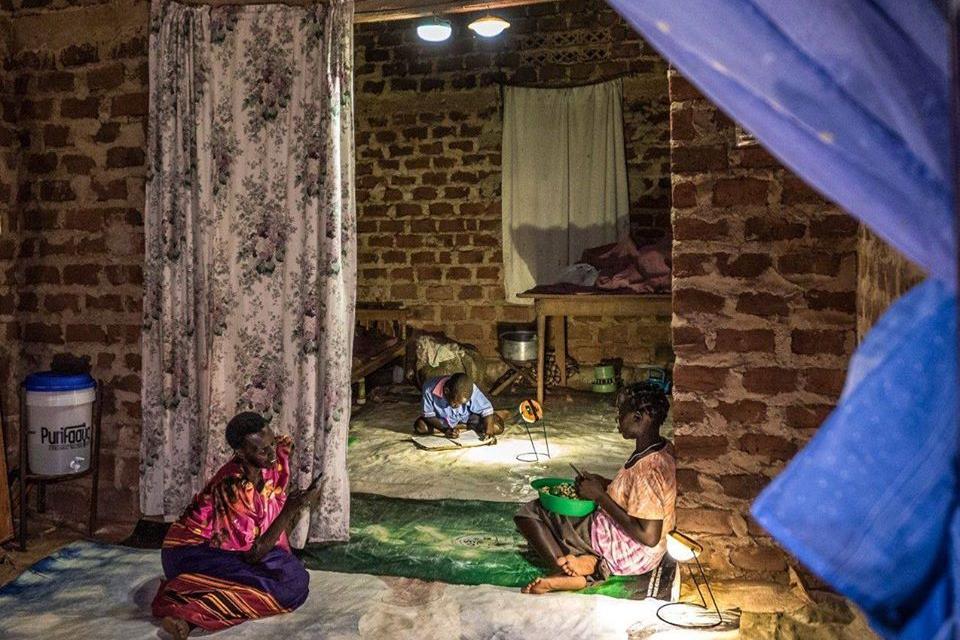
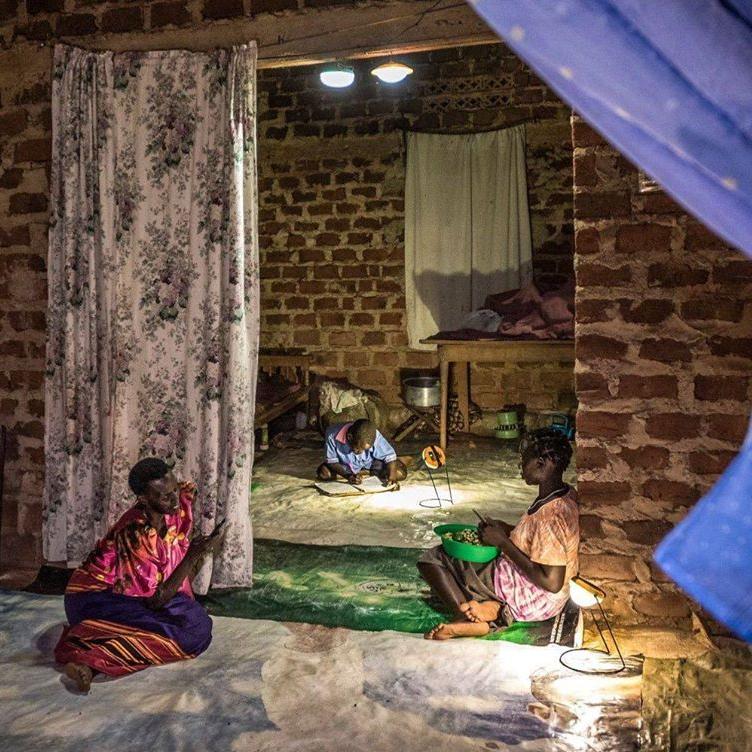
2020’s arrival started a ticking clock on our most urgent global development goals—most notably, the United Nations' Sustainable Development Goals (SDGs). While the New Year saw commentary flood the mainstream media with calls for much-needed action on climate change, on another crucial issue with an associated SDG—striving for no poverty by 2030—there has been little discussion.
The prospects for no poverty by 2030 seem daunting: According to UN's Secretary-General Antonio Guterres, the world is largely off-track to achieve the SDGs within the time frame. If we fail, it won’t be because we lack the tools, or even the money, although the distribution of the latter leaves the outcome in serious doubt. But make no mistake: SDG #1, No Poverty, is achievable, and if we act swiftly and collectively, we can get there.
Yes, we can achieve SDGs, including no poverty by 2030 - here's how
After decades at the forefront of developing market-based solutions to global poverty, I have seen firsthand the impact that integrated action can have on poverty alleviation. But we’ll only succeed with meaningful investment (and I don’t just mean financial) from businesses, policymakers, heads of state, faith-based organizations, multilateral development organizations, and NGOs. With this in mind, here are the urgent steps we must take to achieve SDG #1 in this decade.
First, the private sector must invest—big. A troubling 10 percent of the global population (roughly 736 million people) still lives in extreme poverty, according to the most recent World Bank estimate. As Guterres recently stated, “Public resources from governments are simply not enough.” Achieving the SDGs would open an estimated $12 trillion in market opportunities and create 380 million jobs by 2030, significantly raising the standard of living for those at the base of economy pyramid.
It’s in private industry’s interest to spur sustainable development in poorer economies to seek no poverty by 2030—yet the UNDP estimates that only 10 percent of current SDG investments come from the private sector. With an estimated minimum of $5 trillion to $7 trillion in annual resources needed to achieve the SDGs, if corporations are truly committed to re-defining their purpose—heeding the advice of BlackRock’s Larry Fink to account for their corporate social impact—then they should step up to support SDG #1.
With this in mind, we must increase—and vary—investment in Africa. According to the World Bank, the majority of the world’s poor live in sub-Saharan Africa, where the poverty rate stands at 41 percent. In contrast with trends elsewhere, the total number of people living in extreme poverty in the region rose from 278 million to 413 million between 1990 and 2015. Businesses must focus on capital investment in this continent to catalyze growth. But with a heavy concentration of fintech deals and capital in Africa concentrated in just three countries (South Africa, Nigeria, and Kenya), and the current financing gap to achieve the SDGs in Africa estimated at between $500 billion to $1.2 trillion annually, we urgently need to diversify investments.
Basic services are still out of reach for too many people
Second, we must prioritize quality and affordable basic services. For the world’s poorest people, reliable electricity, sanitation, health care, and education are all-or-nothing propositions. Nearly 1 billion people globally live without electricity, 2.3 billion people lack basic sanitation, and similar numbers go without proper healthcare or education.
Furthermore, without the financial services to render these life-enhancing products and services affordable, few can take advantage of them. 1.7 billion adults who remain unbanked, of whom more than half are women. Pairing basic-services access with financing can significantly strengthen a low-income business owner’s chances at economic mobility.
BrightLife, a social enterprise founded by FINCA International, demonstrates such a business model in action: This triple-bottom-line company, based in Uganda, makes clean energy products accessible through secure pay-as-you-go financing. BrightLife’s model builds credit profiles for unbanked populations while solving for essential challenges facing last-mile, off-grid customers (As shown in the above photo, which features a family that benefits from BrightLife's pay-as-you-go solar power service.).
Poverty is inextricably linked to climate change
Finally, we must raise the level of urgency among all stakeholders, including the general public. For wealthy countries, extreme poverty can feel overwhelmingly remote—both geographically distant and intractable. NGOs have a crucial role here: They can show their supporters how they can contribute to global poverty alleviation, and why they must. Greta Thunberg has demonstrated the power of a single activist voice in mobilizing widespread calls for climate action. Yet, poverty and climate change are inextricably linked. We must harness the energy behind the movement to end poverty in our lifetimes. Consumers must call on the companies they purchase from to actively help realize a world without poverty—or it simply won’t happen.
Despite the SDGs’ looming deadline, I’m not without hope. Ensuring that there is no poverty by 2030 is an addressable challenge, and the world has seen significant progress. Thousands of new social enterprises are springing up each year in the developed world and in emerging markets, and many have brilliant solutions to long-standing problems.
According to Nobel Laureates Abhijit V. Banerjee and Esther Duflo, the average income of the bottom 50 percent of earners nearly doubled between 1980 and 2016. Since 1990, the population living in global poverty has fallen by more than 1 billion people, or by 26 percent. But we must cross the finish line—we must end poverty. To deliver on the vital vision laid out by the SDGs, within the next decade, the private sector must massively scale up far-reaching solutions, spurred by the public’s backing. At the dawn of this decade, there’s no time left to waste.
Battery Tech is at the Heart of General Motors' All-Electric Future
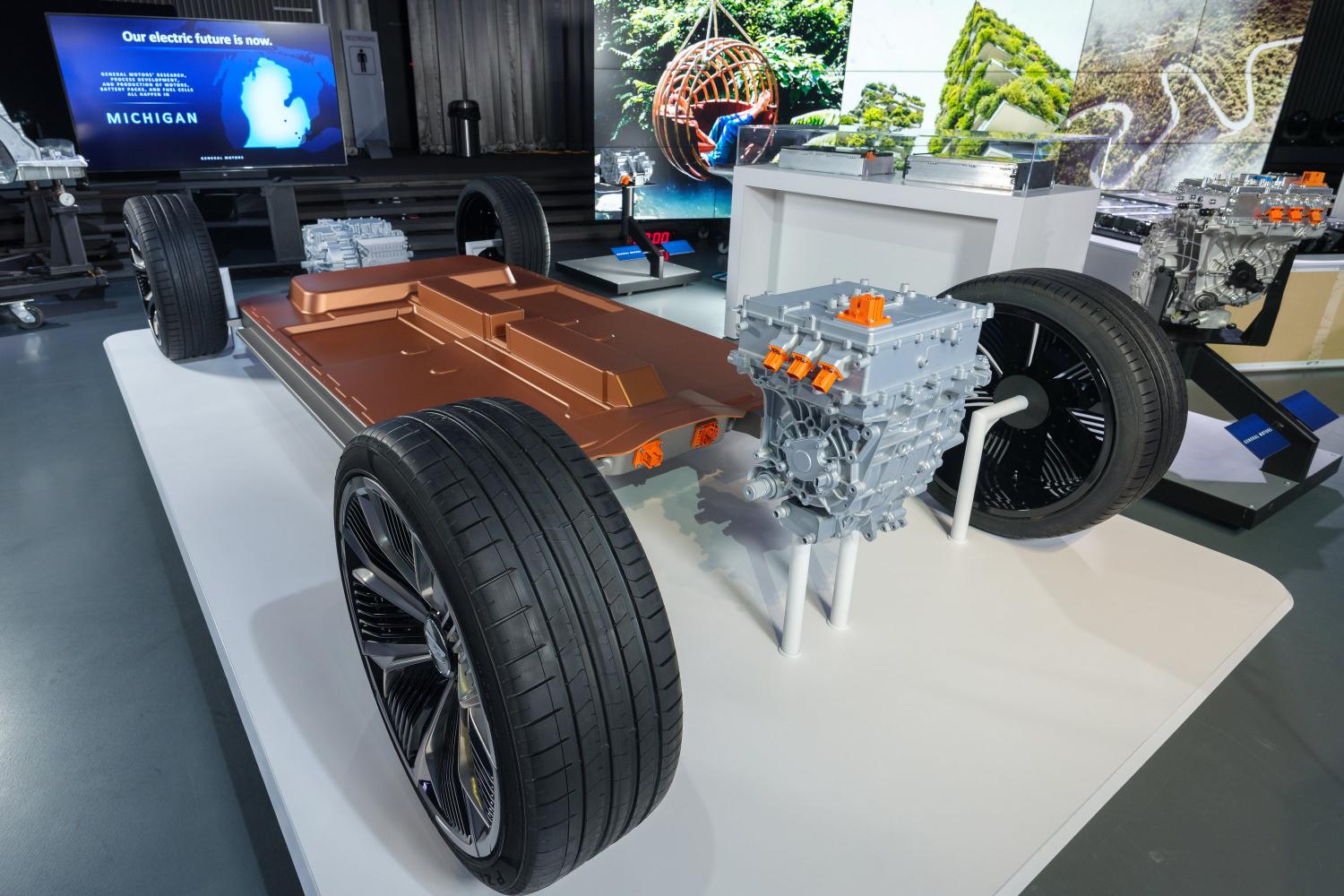

Last week at the General Motors Technical Center in Warren, Michigan, the automaker’s CEO and chairman, Mary Barra, announced a multi-brand, multi-segment strategy that promises a $20 billion investment in both electric and autonomous vehicle technologies over the next five years. The result will be an extensive vehicle rollout by 2025, Barra said.
Positioning the company for an all-electric future, Barra says GM “wants to put everyone in an electric car” and asserted that “a transition to an all-electric future means a focus on sustainability.”
At the heart of GM’s third-generation EV strategy is its new proprietary Ultium battery technology developed in partnership with South Korea’s LG Chem. The new battery platform promises to offer flexibility and scalability in GM’s propulsion technology and will be applied across a broad range of vehicles, delivering an improved driving range at a lower cost.
“The crown jewel is the battery cell itself,” says General Motors
In laying out plans to grow electric vehicle (EV) sales quickly, GM stressed it has to make these automobiles profitable from the outset. By using a modular approach to vehicle architecture, combined with developing a proprietary battery technology, GM believes it has the tools to achieve this.
At the most granular level, GM decided there was long-term value in developing its own battery cell, which it could package optimally for vehicle design. The automaker deemed this a better approach than relying on bundling commoditized cylindrical lithium-ion cells, which are found as components within many other auto battery packs.
GM’s resulting “pouch cells,” which look like relatively thin rectangular slabs, can be stacked like toy bricks, allowing for superior packaging density. Think about the wasted space in between a bundle of cylindrical cells, and you can appreciate the advantage of brick-like alternatives. One of GM’s large-format pouch cells is equivalent to 20 cylindrical cells.
The pouch cells themselves are then built into battery modules, with each module containing up to 24 pouch cells. Depending on vehicle requirements, six, eight or 10 modules will be configured into a vehicle battery pack, as shown below.
Photo: Battery modules can be seen in the cutaway part of the vehicle (courtesy General Motors).
This modular approach offers GM the flexibility to create a range of battery pack sizes using common building blocks. This process allows engineers to build smaller battery packs for lighter vehicles more efficiently, while combining a greater number of modules for up to a planned 200 kilowatt-hour battery pack for the automaker’s largest SUV.
In addition to efficient packaging, reducing cost and optimizing battery performance are also among the ultimate goals, GM says. Indeed, the auto industry’s holy grail has been to reduce battery costs to below $100 per kilowatt-hour, at which point EVs should become cost-competitive with internal combustion engine cars.
In developing Ultium, GM still says it is “nowhere near the bottom of the battery cost curve” and promises to continue to drive the cost and performance envelope going forward. But the automaker confidently says its Ultium system will break the $100-per-kWh threshold and, not only that, asserts a million-mile battery life “is within striking distance.”
Ultium is somewhat future-proof, too. If an individual module fails after several years in service, instead of replacing the whole battery pack, which is today’s proposition, an Ultium pack will allow the failed module alone to be replaced — saving cost and, indeed, waste. Furthermore, if future battery chemistry changes before a module fails, an Ultium battery pack will allow the integration of a new module with a different cell chemistry since it will be able to “read” what type of new module has been installed.
The smart thing here is that GM is building a battery platform which is adaptable to developments in battery cell technology, which remains in a great deal of flux, without rendering an older battery pack or design architecture prematurely obsolete. There’s both a benefit to the company and the consumer with this approach.
Ultium could reduce the use of scarce resources
From an environmental standpoint, although EVs have the capacity to reduce carbon emissions and improve air quality, battery components themselves are not without harmful environmental impact.
One problematic element used in vehicle batteries is cobalt which, as well as being rare, has the additional hazard of frequently being sourced from conflict zones around the world.
Alleviating this problem somewhat, Ultium batteries will use a higher nickel, lower cobalt battery chemistry which GM says results in a 70 percent reduction in cobalt content compared to the typical lithium-ion batteries available today. As the technology is further refined, GM says it is working on zero-cobalt and zero-nickel batteries, too.
As much as possible, the company says it aims to source the supply of battery materials from within North America, which should help to localize the supply chain for its new manufacturing plant being built in partnership with LG Chem in Ohio, which will be the approximate size of 30 football fields.
At end-of-life, GM says it has a 100 percent record so far of repurposing any returned battery packs for a second life. Furthermore, the company expects the new pouch cells to be easier to deconstruct for recycling when, following a reuse phase, a battery module is ultimately too depleted to be useful.
So, what does this mean for the customer?
Ultium is at the heart of GM’s new range of EVs which, coupled with a new generation of EV power units, will offer customers considerable choice of electric vehicles from the company over the course of the next five years.
Today, GM’s EV offering is the Chevrolet Bolt, a small car with a current range of 238 miles on a single charge. Out of the gate, the Bolt offered the best range in the sub-premium segment, but if its design didn’t suit a consumer's needs, there simply wasn’t any other choice.
We’ll follow up in the very near future to drill down into forthcoming vehicle offerings from General Motors — and how customers’ choices are about to become much broader.
Disclosure: The author’s attendance at the press event in Michigan was paid for by General Motors. Views expressed are those of the author.
Image credits: General Motors Corporate Newsroom
Climate Change Could Eventually Mean the End of Beach Season


Beach season is just around the corner, but your favorite sandy spot may not be around too much longer if climate change has anything to do with it.
A recent study published in the journal Nature Climate Change found that half of the world’s sandy beaches could disappear by 2100. If that seems too far off on the time horizon to worry about, consider that about 15 percent of those beaches already face severe erosion and could be gone by 2050. If you live in Australia, the U.S., Mexico or the Caribbean, that timeline could be even shorter.
The study sets the erosion limit at 100 meters, and when looking at threatened beaches, the impacts could become severe in many of the world’s most densely-populated areas. Regions including the eastern seaboard of the U.S., Southeast Asia and Central Europe are within that range — meaning they are at risk of having no more beaches for summer sunbathing.
Several causes of beach erosion exist, including natural wave erosion and geology (beaches naturally shift over time), coastal development, dams and damaging storms. But none of those factors pose the same level of threat as rising sea levels, especially when coupled with the fact that climate change is causing storms to become more intense and damaging. It’s food for thought, especially since beach season squarely lines up with hurricane season, which starts on June 1.
Texas is a microcosm of coastal erosion problems
Cameron County, Texas, is the state’s southernmost county and one of the poorest in the country, with a poverty rate of around 28 percent (compared to the U.S. national average of 11.8 percent). But this area is also home to one Texas’ most popular beach destinations: South Padre Island (SPI).
SPI is home to less than 1 percent of Cameron County’s population, but contributes around 5 percent of the county’s total economic output. However, Cameron County’s beaches are also eroding at an alarming rate. Near the mouth of the Rio Grande, where the river ends at the Gulf of Mexico, beaches are eroding by more than 20 feet per year. And while Houston scored most of the national media attention after Hurricane Harvey, the southern counties in Texas are still reeling from floods in the two years since. Texas overall has more federally-recognized disaster declarations than any other state, and averages a hurricane every three years.
Coastal erosion results in the loss of tourism dollars worldwide as well as all the ancillary economic benefits associated with tourism. For example, one study put economic losses related to coastal erosion for the Hoi An region in Vietnam at $29 million by 2040. The U.S. government estimates that coastal property losses in the U.S. are already costing $500 million per year. When compounded with the fact that those most unable to bounce back from the impact of coastal erosion are the poorest and most vulnerable populations, inland areas may have to contend with an influx of people from coastal areas.
The threat to beach season and climate change: what can be done?
These figures are daunting, but there is some room for hope. A two-pronged approach could help mitigate some of the worst impacts. Resilience and adaptation strategies are needed to deal with the current and recent issues facing coastal communities, such as building natural infrastructure (as opposed to dams or sea walls, which may offer a short- to medium-term solution, but are costly and not as effective for long-term resilience to increasingly intense storms). Also, better flood plain maps and stricter building codes in coastal areas are essential for resilience.
The second prong is taking substantive action on climate change. The Nature Climate Change study found that by limiting carbon emissions, predicted coastal erosion could be reduced by 17 percent by 2050 and by 40 percent by 2100. That is significant, not only for those of us who live inland and visit beaches, but the communities that live in and around beaches all over the world. Some loss will happen, but smart climate and resilience policies can minimize those losses, to the benefit of us all.
Image credit: City of South Padre Island/Facebook
Happy Family Organics Scales Up Awareness of Regenerative Agriculture


A new line of baby food, which Danone’s Happy Family Organics sources from farms practicing regenerative agriculture, could help boost such efforts across other food companies' supply chains.
How the line stand outs on store shelves could make a difference in whether consumers become more enthusiastic about products that food companies like Happy Family and its parent company, Danone, source from land where farmers adopt regenerative agriculture techniques.
Regenerative agriculture: One method for reducing a farm’s carbon footprint
Each industry has its own challenges with sustainability, and agriculture is no exception. According to the World Economic Forum, the top five global risks facing society all involve the environment, and agriculture is one industry that needs to become far more sustainable.
That’s where regenerative agriculture enters the picture.
Regenerative agriculture is farmland management that nurtures and improves soil through methods including no-till planting, crop rotation, and integrating plants with roots that can help prevent erosion. Such farming methods go further than feeding today’s consumers and seek to provide for the next generation by protecting the natural resources used in crop production. In sum, regenerative agriculture goes far beyond doing no harm to land — it can actually improve the quality of the land in the long run.
Regenerative agriculture a win for the environment, farmers and consumers
Although regenerative agriculture can result in the decrease of yields from farm to farm, the value of “quality over quantity” rings true as the practice offers some long-term rewards. In a study involving 20 farms, those using regenerative practices experienced an almost 80 percent increase in profits compared to those that used more traditional farming methods. The enhanced soil health can also result in higher-quality produce, which in turn grocers can sell at a higher price.
A shift to regenerative agriculture can also result in removing carbon from the atmosphere and channeling it back into the soil, producing healthier crops while reducing greenhouse gas emissions. Additional methods, such as the planting of cover crops, reduces unhealthy runoff from reaching water sources. The rebuilt soil is also more efficient at holding water and requires less irrigation than traditional cropland.
These benefits go far beyond impacts on farming practices or the environment. To that end, the moves Happy Family is taking to include regenerative agriculture within its supply chain offers an opportunity to bolster its reputation with farmers, as well as with consumers determined to buy products with a positive environmental and social impact.
Happy Family’s new line of baby food includes three flavors of purees, with the potential for more coming soon, the company says. Last year, Happy Family said it sourced 300,000 pounds of produce from farms that incorporated regenerative agriculture; this year, it plans to source over 2 million pounds of such fruits and vegetables.
The challenge: Educating consumers about regenerative agriculture
The presentation of Happy Family’s new line could help influence the decisions consumers make when they purchase baby food and other food products. The packaging prominently displays the slogan Farmed for Our Future, and the colorful labels include a “regenerative and organic” logo and more information about the farming practices. Other companies, such as organic food company Annie’s, have used a similar packaging technique to inform consumers about the long-term benefits of regenerative agriculture.
To date, Happy Family claims it has sourced more than 150 million pounds of organic fruits and vegetables that do not contain any pesticides, antibiotics, synthetic fertilizers or growth hormones. The brand says it has also increased its recycling efforts, as its packaging is not recyclable in all municipal waste collection systems. On that point, the company has pledged to make 100 percent of its packaging recyclable, reusable or compostable by 2025.
Image credit: Happy Family Organics/PR Newswire
#BiasCorrect Campaign Pushes Back Against Gender Inequality in the Workplace


Bossy. Aggressive. Pushy. Cold. These are just some of the terms used to describe women in the workplace, according to Catalyst, a global nonprofit that works with CEOs to build gender equality. To mark International Women's Day (March 8) and Women's History Month, the 48-year-old organization is reprising its successful #BiasCorrect campaign — which aims to reclaim the power of words to fight unconscious gender bias.
#BiasCorrect launched around this time last year, featuring images of influential women emblazoned with biased terms used to describe them in the workplace. (Both Facebook COO Sheryl Sandberg and former Secretary of State Hillary Clinton were once labeled "bossy" by their coworkers, in case you were curious.)
Catalyst and its campaign collaborator, women-led brand strategy firm Burns Group, invited women on social media to share their own experiences with gender-biased language using a photo generator that placed their experiences alongside famous women.
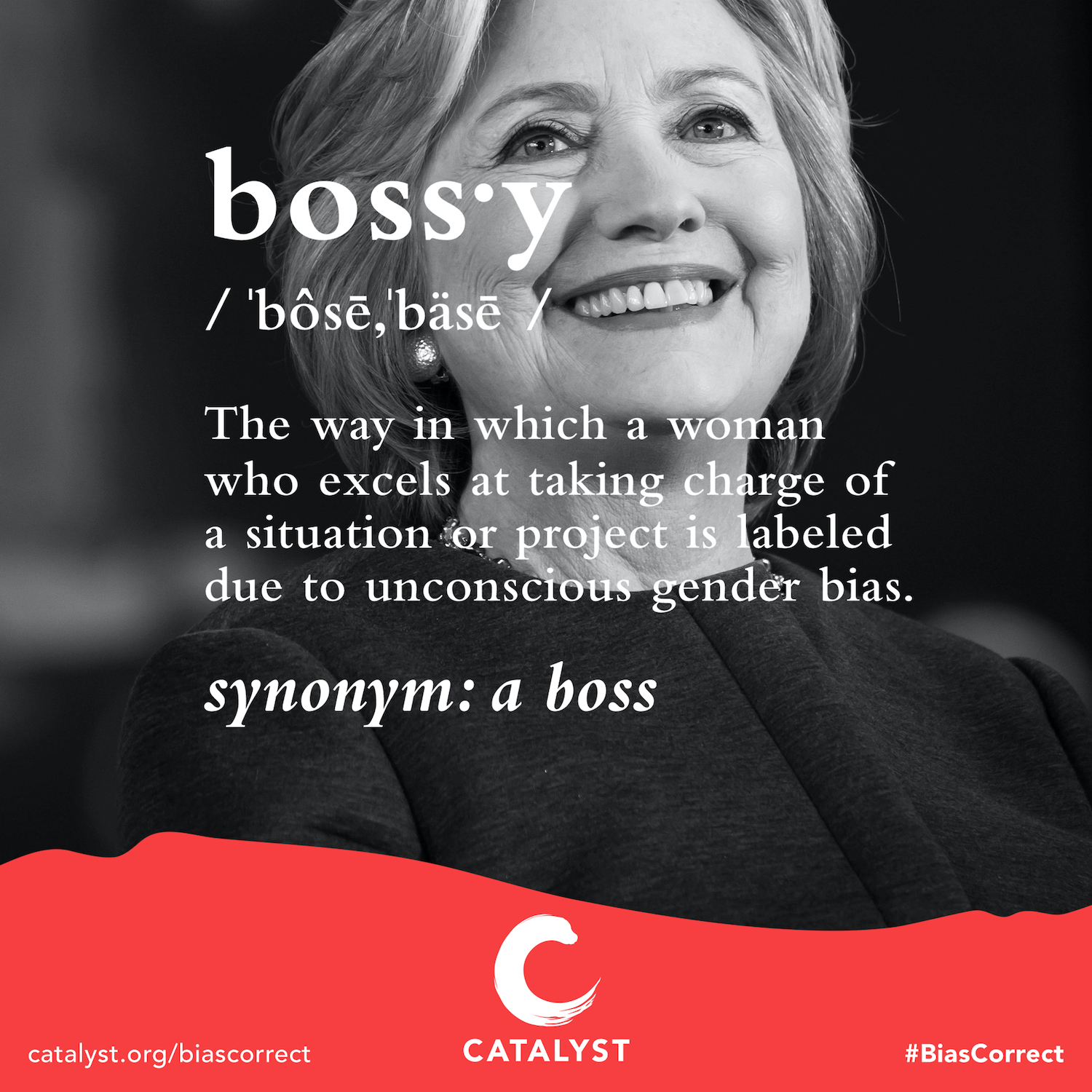
The response was overwhelming. The #BiasCorrect hashtag generated more than 32 million impressions on Twitter, and the 2019 campaign reached more than 188 million people across six continents, according to Catalyst estimates.
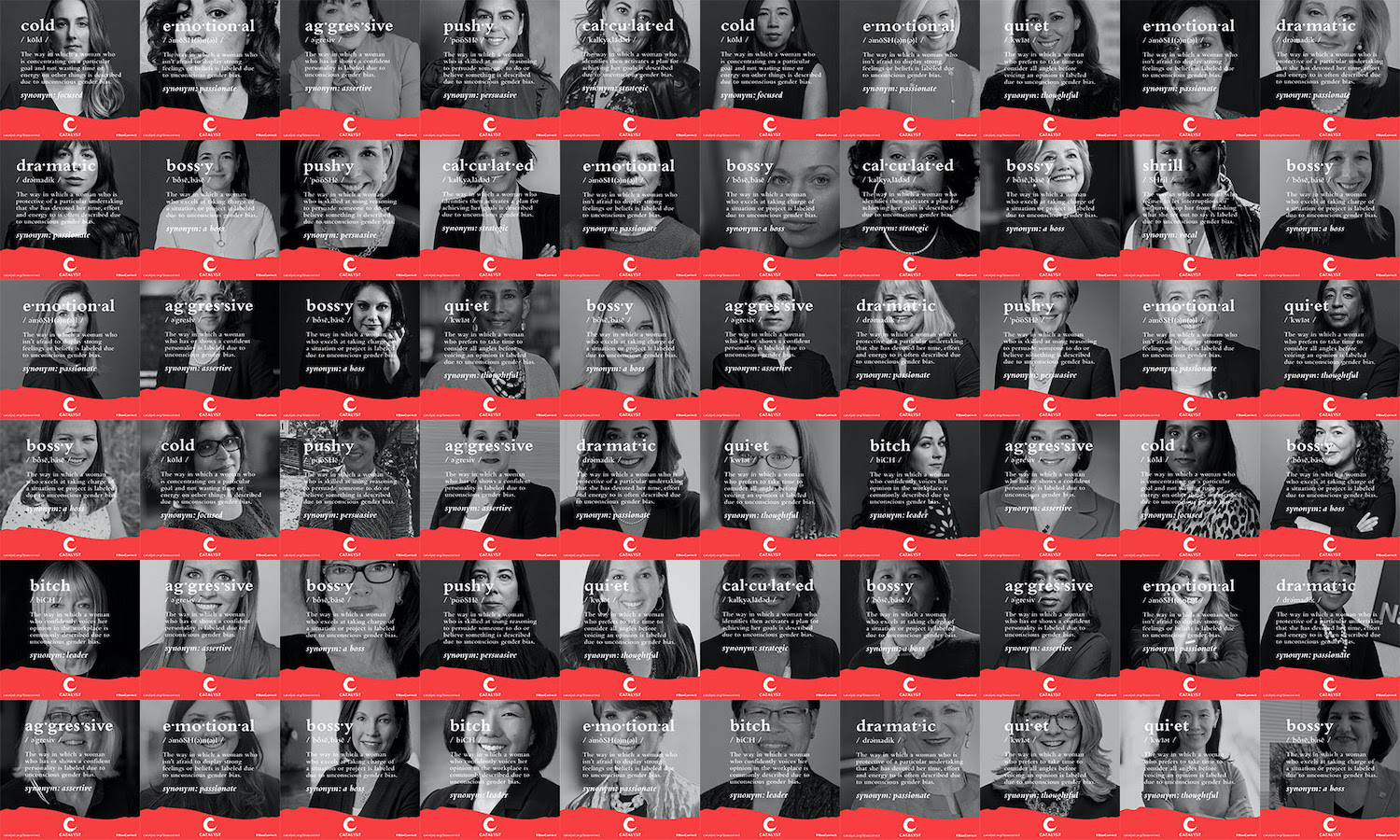
Some women recalled being labeled as "calculated" and "shrill," while others were dismissed as "quiet" or "emotional."
The lose-lose dichotomy between too forceful and too timid echoes the reality that is often described by researchers examining women's experiences at work. Catalyst's own surveys document the prevalence of micro-aggressions and gender-biased language in corporate workplaces, particularly for women of color, who say they feel constantly "on guard" and hyper-aware of how they are perceived by coworkers.
Along with visuals that turned these misconceptions on their head, the 2019 iteration of #BiasCorrect included a plugin for the instant-messaging platform Slack, which spots bias in word choices and suggests alternative terms. In the 12 months since, nearly 300 organizations have downloaded the plugin.
In 2020, this fight against gender bias enlists men
Following the runaway success of the 2019 campaign, this year's iteration of #BiasCorrect has the potential to be even bigger, thanks to a call-to-action specifically geared toward men.
"The response to last year's #BiasCorrect campaign confirmed that many people are unaware of the impact of unconscious gender bias in the workplace," Lorraine Hariton, president and CEO of Catalyst, said in a statement. "We knew it was important to continue to educate everyone about how language affects inclusion."
As women continue to use the #BiasCorrect photo generator to share how their roles, skills and potential are described at work, this year men are invited to do the same. The aim is to illustrate how women and men with similar skillsets are often described very differently, creating barriers that prevent women from advancing in their careers or feeling accepted and appreciated at work.
The Slack plugin is also available in three additional languages for 2020, French, German and Spanish, and it's available as an open-source code that can be adapted for other messaging platforms.
"We know the problem isn't fixed, and we're engaging men as gender partners in our 2020 #BiasCorrect campaign to interrupt bias and help women advance," Hariton said. People are already responding, and Catalyst started to circulate side-by-side comparisons on social media over the weekend.
On the surface, it may seem as if women are the only ones negatively impacted by gender bias in the workplace, but research indicates that's simply not the case. "It's an unfortunate truth that gender bias is universal," said Joanne McKinney, CEO of Burns Group.
Studies show men are often penalized for straying away from masculine gender norms at work. When male leaders ask questions, for example, they're more likely to be perceived as incompetent compared to their female counterparts. When they advocate for their teams, they're more likely to be perceived as weak. One study even shows that men who are nice to their coworkers earn almost 20 percent less on average. What in the patriarchal hell.
But, if the initial response to the #BiasCorrect campaign is any indication, men are all too willing to join the conversation — and to start asking more questions about why we tend to be so rigid about who and how our coworkers should be. And that's good news for all of us.
Visit the #BiasCorrect website to learn more and to browse bias-busting resources for both men and women.
Image credits: Christina @ wocintechchat.com via Unsplash and Catalyst
This Family-Owned Company in Oregon Helps Empower Women Farmers Abroad
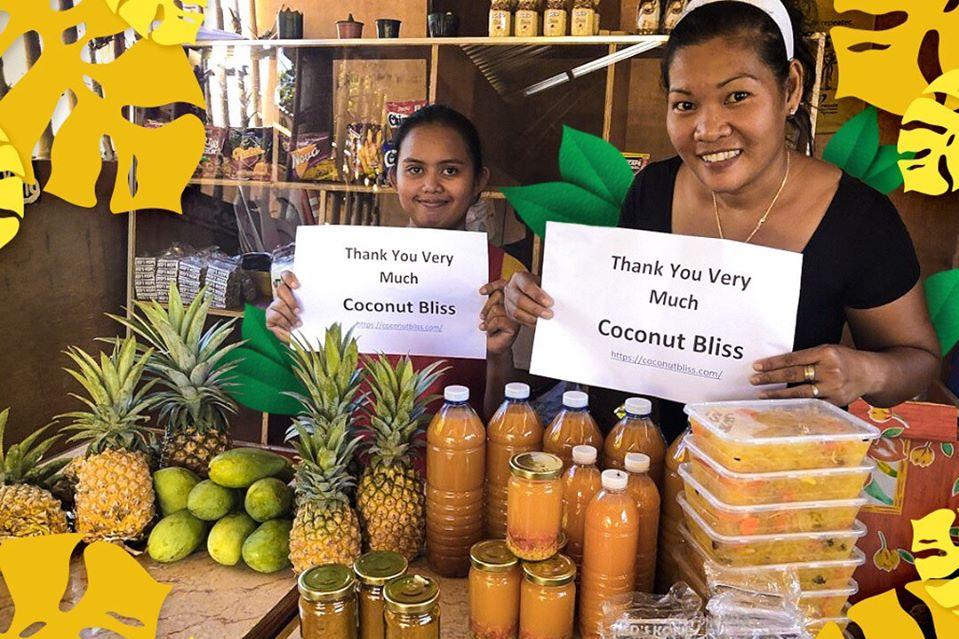
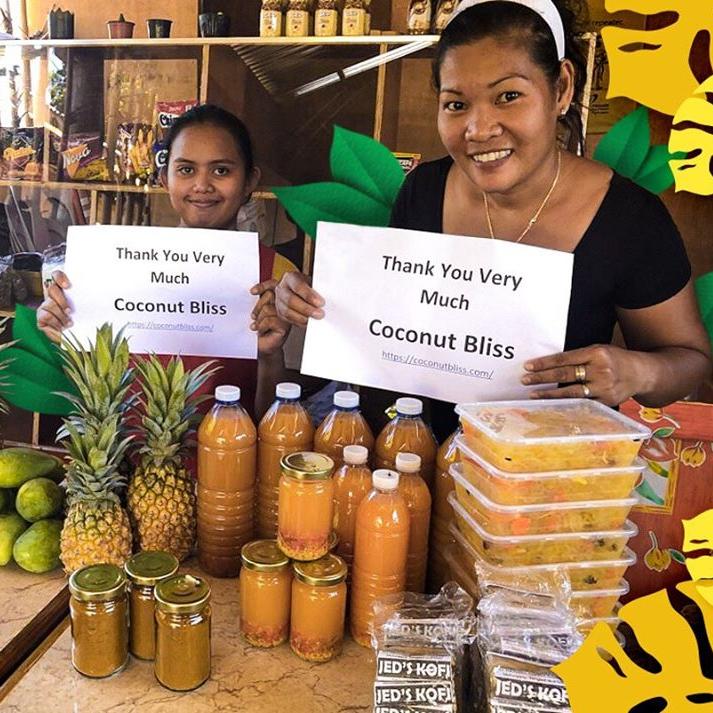
Coconut Bliss, a family-owned company that makes vegan coconut ice cream from organic, sustainable and fairly-traded ingredients, is empowering women from their farms in the Philippines to start their own coconut-based enterprises.
The Philippines ranks highest in Asia when it comes to gender equality and, until recently, ranked in the top 10 worldwide, according to the most recent World Economic Forum (WEF) Gender Gap Report. The country has closed 78 percent of its overall gender gap and 80 percent of what WEF describes as the economic participation and opportunity gender gap; it is only one of four countries to achieve this feat. The report ranked 153 countries based on four categories: economic participation and opportunity; educational attainment; health and survival; and political empowerment.
In line with this year’s International Women’s Day theme “an equal world is an enabled world”, Coconut Bliss’ work with farmers demonstrates that, in an environment like the Philippines which is conducive to women’s development, a little capital and support can go a long way.
“Since its inception in 2005, Coconut Bliss has supported various causes. However, we wanted to create a program that focused on the regions where our resources come from and addressed both sustainability and climate change,” explains Darcey Howard, global marketing director for Oregon-based Coconut Bliss.
To that end, the women-led company has developed a program with Water, Agroforestry, Nutrition and Development Foundation (WAND) to improve the lives of women farmers and their families by helping them to find alternate means of revenue and capital to start their own business.
“At coconut harvest every three months, the income from coconuts is just enough to support the day-to-day survival of a small farming family. And, due to the fluctuating price of coconuts, along with stiff competition from cheaper high-demand products like palm oil, there is an urgent need to provide such families dependent on coconuts with an alternative means of earning income,” writes Cora Sayre, Coconut Bliss’ representative in the region who helps ensure the success of the program.
Coconut trees are considered a “miracle tree” with many revenue opportunities like coconut husk fertilizer, charcoal from coconut shell, coco peat, and vinegar from coconut water. The program helps women develop and sell such products.
“Production is one process we support, however we realized that scaling up the marketing of the products produced by the women requires a lot of work, so we support them to ensure the pricing and packaging is on par with competition and that the vendors are engaged to market their products,” Sayre continues. “The women’s associations we are working with are now able to sell their products in 56 outlets across three municipalities, and they hope to expand soon.”
What’s more, the shade from coconut trees allows growth of shade-loving spices, banana, pineapple, cacao, jackfruit and other food crops. “We have supported the gardening activities of 315 women by providing vegetable seedlings, organic fertilizer and training," Sayre explains. "The repayment from the sale of their surplus is used to engage other women to undertake gardening in their own homes."
“We identified a percentage of the purchased volume of coconut products from the regions we are supporting that we could apply to developing a program that is baked in way that we’re giving back to the communities that are helping us make our ice creams,” Howard adds. “The project overall has provided improvement of the social and economic standing of 650 women and their families who are dependent on coconuts for their survival. These efforts also showcase the income possibilities that can be generated from coconut-based farming that may have been previously overlooked or taken for granted.”
Empowering women was a natural fit for Coconut Bliss, Howard continues: "Not only is our company women-led, but we drew inspiration from Project Drawdown. They emphasize that empowerment for women is not only a positive movement for our society, but benefits our planet as well." Similar to the U.N. Framework Convention on Climate Change (UNFCCC), Project Drawdown takes insight from the findings of 300 scientists to conclude that women and girls are pivotal to addressing climate change successfully.
“Sustainability has always been a value for us that is carried throughout Coconut Bliss’ product lifecycle — from sourcing, to manufacturing, to consumption. A substantial sustainable priority of ours is to source high-quality ingredients from partners that are doing good works in their respective regions, such as Lockhead Vanilla that builds fresh water wells in the region of Madagascar where their farms are located. We also work with Mazie Jane’s Almonds who operate bee-friendly organic orchards in California,” Howard says.
“We’d like to expand this program (with WAND) as we grow to include additional regions where we are sourcing ingredients, such as Thailand, Madagascar and even the United States."
Image credit: Coconut Bliss/Facebook
